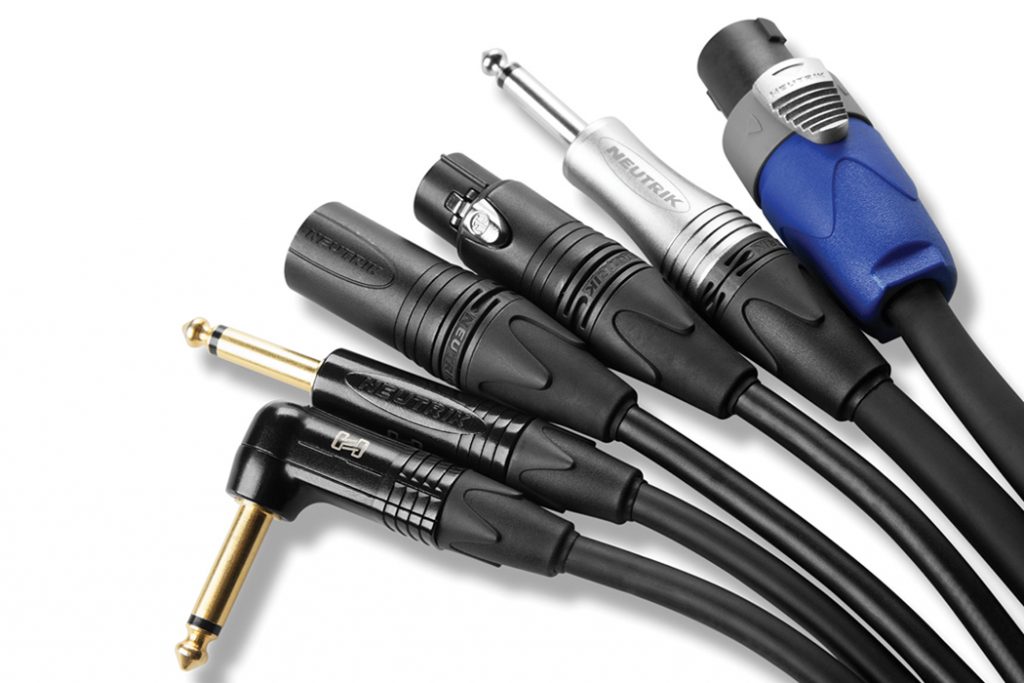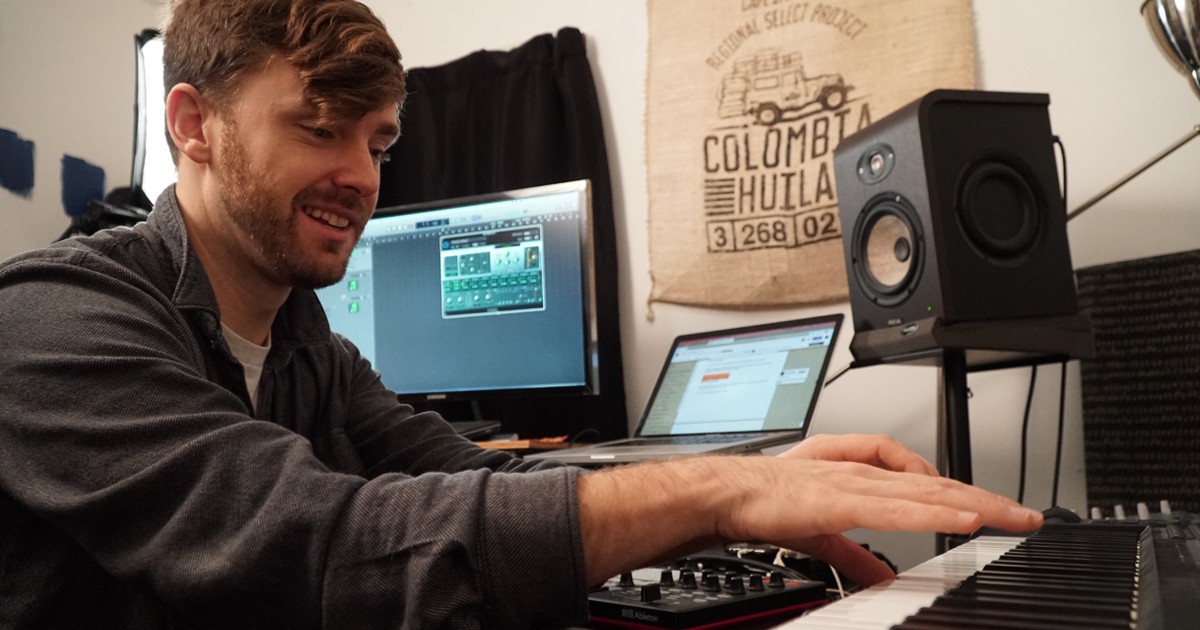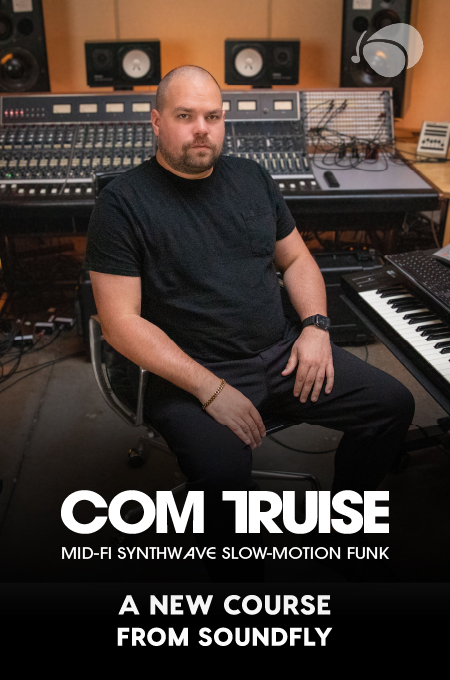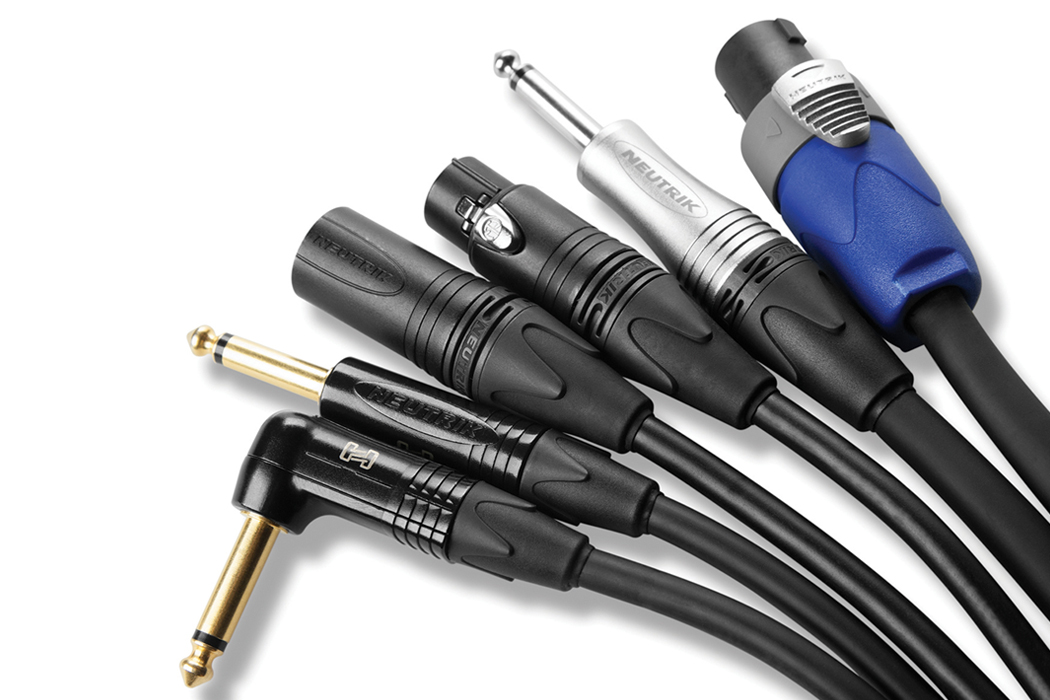
+ Learning to record and mix music at home? Soundfly’s online courses on mixing, producing, and beat making can help! Preview for free and subscribe for access.
Unfortunately, you can’t connect your audio gear straight to your brainwaves yet. So whatever innovative ideas you’ve got brewing in your head are still going to have to flow through some kind of cable to make it out of the speakers.
As far as we’ve come, cabling is still the heart of the studio and stage experience, and something you should take seriously. We can help.
Here is a basic primer on everything you need to know about picking out audio cables, their types, and how they function.
Balanced vs. Unbalanced
First you need to know the difference between balanced signal and unbalanced signal.
Balanced signal uses three wires: ground, positive, and negative. Plus and minus carry the same information with opposite polarity. Balanced devices receive signal and flip one side’s polarity, bringing them back into phase — which happens to put noise out of phase with itself — cancelling it out.
Hence, the key takeaway: Balanced connections reject noise.
Unbalanced signal uses only two wires. So they are simpler, cheaper, and noisier. Unbalanced cables may work in short runs (under 25 feet, or well, under 6 if you’re naughty), and some of your gear might also be unbalanced. If all of your gear is unbalanced, using balanced cables won’t help you much with the noise thing, but it won’t hurt either. If your gear is balanced, you’re better off using balanced cables all around if you can afford it.
Older gear like vintage outboard gear, anything with RCA type connectors like record players, and instruments such as guitars and basses all tend to be unbalanced. On the other hand, microphones, mic preamps, and mixers are normally balanced. Again, pick balanced cables unless money is an issue, the runs are short, and/or every single piece of gear is unbalanced (unlikely).
+ Read more on Flypaper: “The 13 Most Common Mics You’ll Find in a Studio, and Why Engineers Rely on Them.”
Speaker vs. Instrument Cables
If you’ve skipped ahead, you’ve noticed that you can tell a balanced cable from an instrument cable by looking at the connector. Unfortunately, that’s not so with speaker cables vs. instrument (aka guitar) cables.
Nevertheless, it does matter. Speaker cables are unshielded, which means if you grab one to connect your guitar to your amp, you’ll pick up noise from other sources (the “Mexican radio” problem) as well as interference from devices, and generally end up with a noisy, ugly result.
It’s even worse in reverse. Using an instrument cable on a speaker such as a powered monitor or separate amp/loudspeaker can cause major-league harm to your amp.
Because instrument cables have smaller wires, you’ll be sending a high amount of current to your amp; way more than it can actually handle. Things may be fine at first, but eventually you could cause a short in the amp, melt the cable, or worse yet, look stupid in front of your bandmates.
So how do you tell the difference? Read the package and label everything clearly.
+ Learn production, composition, songwriting, theory, arranging, mixing, and more — whenever you want and wherever you are. Subscribe for unlimited access!
Connectors
This is probably the reason you came here in the first place. Here’s a run down of typical audio connectors.
Pro Tip (pun definitely intended): If you can tell the difference between the first two, you’ll know if a cable is balanced or not by looking at the connector.
TS
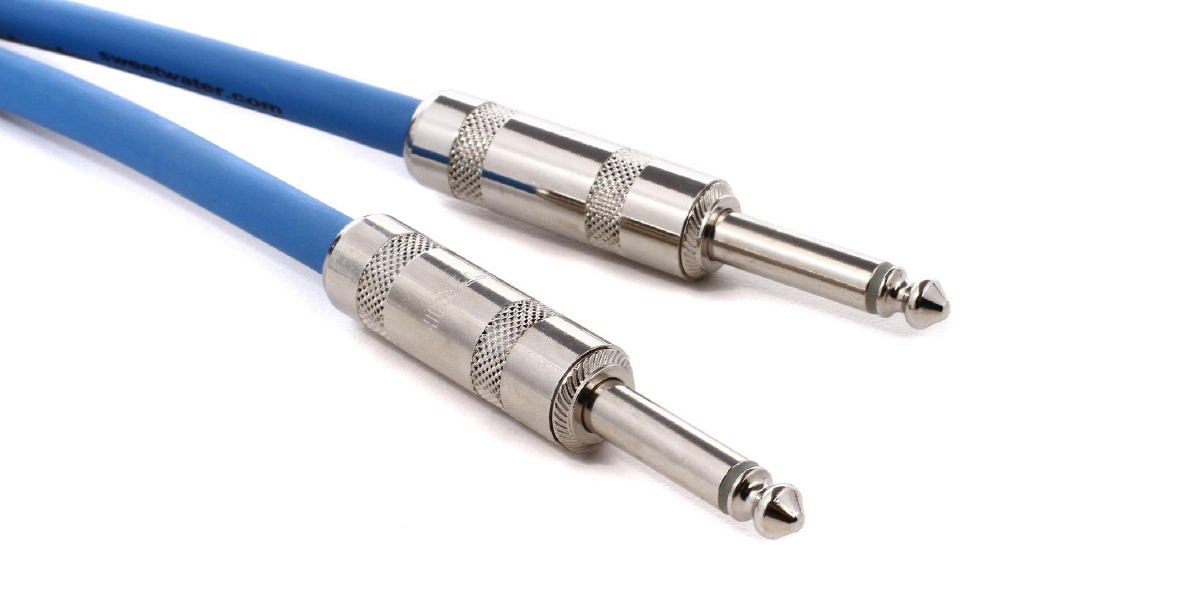
TS stands for tip/sleeve. Think of a guitar cable or a speaker cable. These are also commonly known as quarter-inch mono or phone jack. Notice there are two terminals. The tip (literally) and the sleeve (below the little line). That’s two channels. Wanna guess whether this is a balanced or unbalanced connector? (Hint: Unbalanced.)
TRS
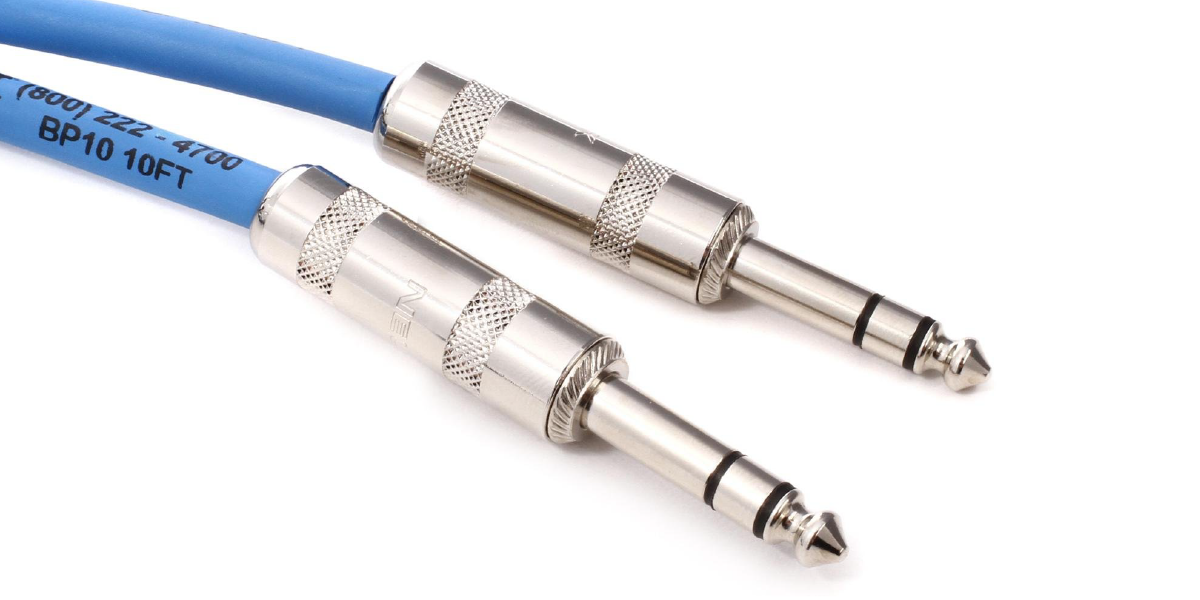
TRS stands for tip/ring/sleeve. These are also known as quarter-inch stereo or quarter-inch balanced cables. Notice the extra little line in the connector, creating a tip (literally!), ring (the middle part), and sleeve (as before). TRS connectors are balanced, and they can be stereo.
Why? Because they have two discreet channels, so they could carry stereo information instead of balanced mono information. Take a look at your headphone connector and you’ll see a tip/ring/sleeve connector; this signal is split into two before it gets to each side of the headphones’ speakers.
You’ll also see TRS connectors on one end of insert cables. In this case, the signal is split into two not for stereo purposes, but for output and return.
Mini TRS
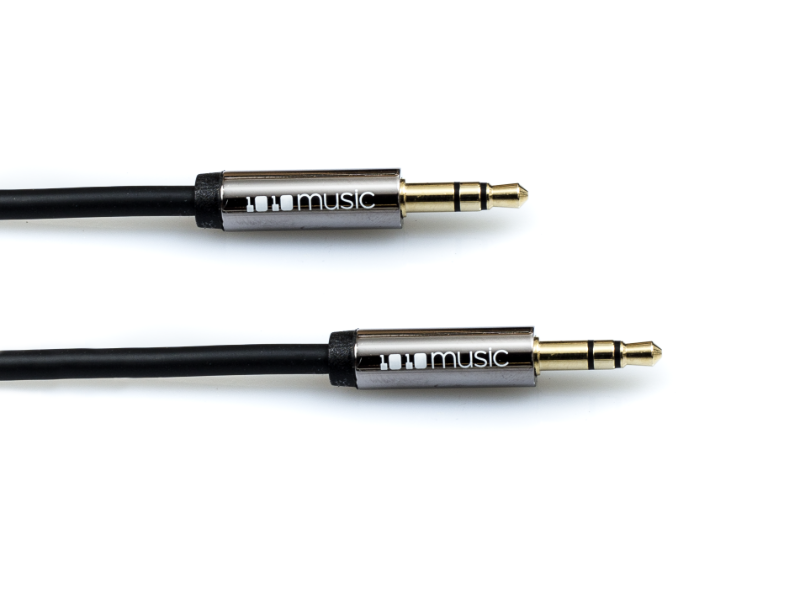
1/8th inch tip/ring/sleeve connectors, also known as Mini TRS, are used for earbuds, many y-cables that you would use to connect your laptop’s headphone outputs to a mixer, and some headphones. Look for the three terminals on the connector – if you only see tip and sleeve, it’s not a stereo connector, which means you can’t listen to your tunes in all their glorious fidelity.
XLR

XLR cables are also known as mic cables. Old-school blokes call them cannon connectors. Unlike other types of cables, XLRs are male on one end and female on the other, indicated by the three pins. This is handy; output is male (you know why) and input is female. XLR connections are also balanced. Mics and mic preamps aren’t the only place you’ll see them. They’re also used in AES/EBU digital cables (although the cable itself is a bit different), and you may come across an XLR patch bay in your favorite studio.
RCA

RCAs are also called phono connectors. These are unbalanced. You’ll see the female side on mixers labelled “tape in/out,” on the back of consumer electronics such as TVs and video game consoles, and (interestingly) as S/PDIF digital inputs on audio gear. Technically, S/PDIF (Sony/Philips Digital Interface) cables are more robust, and it’s better to opt for a true S/PDIF cable for these connections, but a regular old RCA cable will do fine in a pinch. RCA connectors are also typical in the y-cables mentioned above.
+ Read more on Flypaper: “What Is a Mic Preamp, and Why Do I Need One?”
Other Types of Cables
There are of course many other types of connectors you’ll see less often. These include but are not limited to banana plugs (speaker/amp systems), speakON (stage monitors and pro PA stuff), BNC (coaxial and video connections), optical (digital audio), DB25 (computer-like connections with multiple channels in a small space), Elco (similar idea to DB25), and tiny telephone or “bantam” (miniature TRS connectors typical for large studio patch bays — very space-saving).
That’s pretty much it.
In fact, that may be more than you actually need to know. You’ll notice we didn’t talk about Monster cables and Mogami cables and thousand dollar per foot, gold-plated, custom cables from Japan. All those things may be great, and they may float your boat, but for the most part, any solidly made cable will do the job in audio. As long as you pay attention to balanced vs. unbalanced and speaker vs. instrument cables, and make sure you prepare your connections, you’ll be fine.
Until telepathic wi-fi brainwave-enabled audio is invented, we hope this helps.
Continue learning with hundreds more lessons on mixing, home audio production, recording, beat making, and much more, with Soundfly’s in-depth courses, like Modern Pop Vocal Production, Advanced Synths & Patch Design, and Faders Up: Modern Mix Techniques. Subscribe for access here.
